Related Research Articles
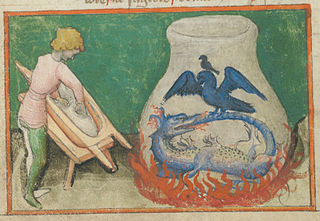
Alchemy is an ancient branch of natural philosophy, a philosophical and protoscientific tradition that was historically practiced in China, India, the Muslim world, and Europe. In its Western form, alchemy is first attested in a number of pseudepigraphical texts written in Greco-Roman Egypt during the first few centuries AD.
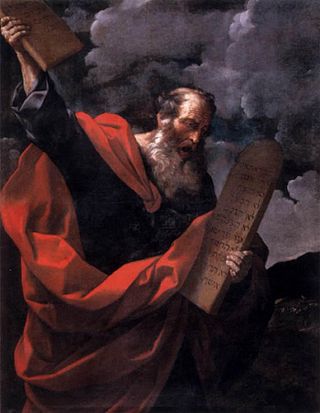
Moses is considered the most important prophet in Judaism and one of the most important prophets in Christianity, Islam, the Druze faith, the Baháʼí Faith, and other Abrahamic religions. According to both the Bible and the Quran, Moses was the leader of the Israelites and lawgiver to whom the authorship, or "acquisition from heaven", of the Torah is attributed.
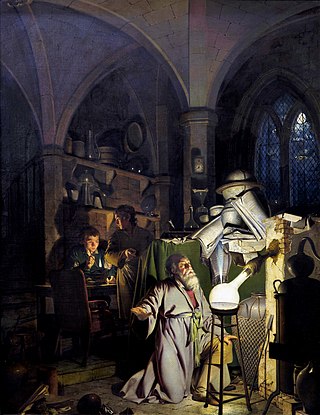
The philosopher's stone is a mythic alchemical substance capable of turning base metals such as mercury into gold or silver. It is also called the elixir of life, useful for rejuvenation and for achieving immortality; for many centuries, it was the most sought-after goal in alchemy. The philosopher's stone was the central symbol of the mystical terminology of alchemy, symbolizing perfection at its finest, divine illumination, and heavenly bliss. Efforts to discover the philosopher's stone were known as the Magnum Opus.
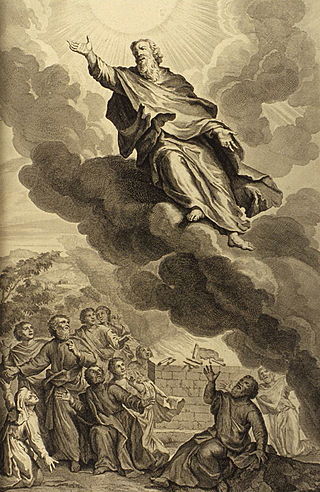
Enoch is a biblical figure and patriarch prior to Noah's flood, and the son of Jared and father of Methuselah. He was of the Antediluvian period in the Hebrew Bible.
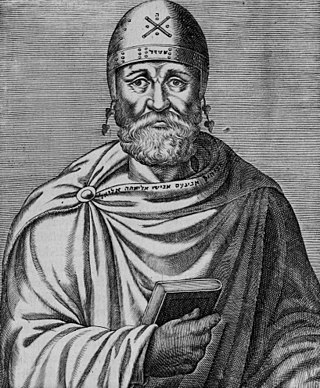
Philo of Alexandria, also called Philo Judaeus, was a Hellenistic Jewish philosopher who lived in Alexandria, in the Roman province of Egypt.

Pseudepigrapha are falsely attributed works, texts whose claimed author is not the true author, or a work whose real author attributed it to a figure of the past. The name of the author to whom the work is falsely attributed is often prefixed with the particle "pseudo-", such as for example "pseudo-Aristotle" or "pseudo-Dionysius": these terms refer to the anonymous authors of works falsely attributed to Aristotle and Dionysius the Areopagite, respectively.
Pseudo-Philo is the name commonly used for the unknown, anonymous author of Biblical Antiquities. This text is also commonly known today under the Latin title Liber Antiquitatum Biblicarum, a title that is not found on the Latin manuscripts of Pseudo-Philo's Biblical Antiquities. Pseudo-Philo's Biblical Antiquities is preserved today in 18 complete and 3 fragmentary Latin manuscripts that date between the eleventh and fifteenth centuries CE. In addition, portions of Pseudo-Philo's Biblical Antiquities parallel material also found in the Chronicles of Jerahmeel, a 14th-century Hebrew composition. The Latin text of Pseudo-Philo's Biblical Antiquities circulated in some Latin collections of writings by Philo of Alexandria. Scholars have long recognized the pseudonymous character of the text now known as the Biblical Antiquities. Primary in this regard is a vastly differing approach to and use of the Jewish Scriptures than that of Philo of Alexandria. For the sake of convenience and due to the lack of a better option, scholars continue to follow the lead of Philo scholar Leopold Cohn in calling the author “Pseudo-Philo.”
Eupolemus is the earliest Hellenistic Jewish historian whose writing survives from Antiquity. Five fragments of his work have been preserved in Eusebius of Caesarea's Praeparatio Evangelica, embedded in quotations from the historian Alexander Polyhistor, and in the Stromata of Clement of Alexandria.

The Emerald Tablet, also known as the Smaragdine Tablet or the Tabula Smaragdina, is a compact and cryptic Hermetic text. It was highly regarded by Islamic and European alchemists as the foundation of their art. Though attributed to the legendary Hellenistic figure Hermes Trismegistus, the text of the Emerald Tablet first appears in a number of early medieval Arabic sources, the oldest of which dates to the late eighth or early ninth century. It was translated into Latin several times in the twelfth and thirteenth centuries. Numerous interpretations and commentaries followed.
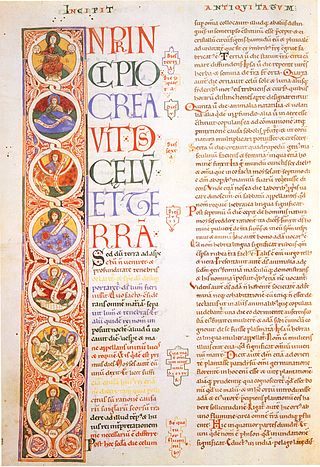
Antiquities of the Jews is a 20-volume historiographical work, written in Greek, by historian Josephus in the 13th year of the reign of Roman emperor Domitian, which was 94 CE. The book contains an account of the history of the Jewish people for Josephus' gentile patrons. In the first ten volumes, Josephus follows the events of the Hebrew Bible beginning with the creation of Adam and Eve.

Mary or Maria the Jewess, also known as Mary the Prophetess or Maria the Copt, was an early alchemist known from the works of Zosimos of Panopolis and other authors in the Greek alchemical tradition. On the basis of Zosimos's comments, she lived between the first and third centuries A.D. in Alexandria. French, Taylor and Lippmann list her as one of the first alchemical writers, dating her works at no later than the first century.

Zosimos of Panopolis was a Greco-Egyptian alchemist and Gnostic mystic who lived at the end of the 3rd and beginning of the 4th century AD. He was born in Panopolis, and flourished ca. 300. He wrote the oldest known books on alchemy, which he called "Cheirokmeta," using the Greek word for "things made by hand." Pieces of this work survive in the original Greek language and in translations into Syriac or Arabic. He is one of about 40 authors represented in a compendium of alchemical writings that was probably put together in Constantinople in the 7th or 8th century AD, copies of which exist in manuscripts in Venice and Paris. Stephen of Alexandria is another.
Artephius is a writer to whom a number of alchemical texts are ascribed. Although the roots of the texts are unclear and the identity of their author obscure, at least some of them are Arabic in origin. He is named as the author of several books, the Ars sintrillia, Clavis sapientiae or Clavis maioris sapientiae, and Liber secretus.
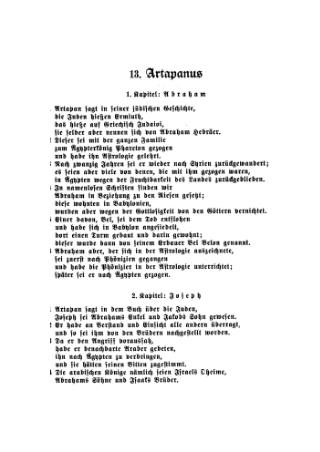
Artapanus of Alexandria was a historian, of Alexandrian Jewish origin, who is believed to have lived in Alexandria, during the later half of the 3rd or 2nd century BCE. Although most scholars assume Artapanus lived in Alexandria, others argue he resided in the countryside. Regardless, Artapanus lived in Egypt.

In alchemy, the term chrysopoeia refers to the artificial production of gold, most commonly by the alleged transmutation of base metals such as lead. A related term is argyropoeia, referring to the artificial production of silver, often by transmuting copper. Although alchemists pursued many different goals, the making of gold and silver remained one of the defining ambitions of alchemy throughout its history, from Zosimus of Panopolis to Robert Boyle (1627–1691).
Stephanus of Alexandria was a Byzantine philosopher and teacher who, besides philosophy in the Neo-Platonic tradition, also wrote on alchemy, astrology and astronomy. He was one of the last exponents of the Alexandrian academic tradition before the Islamic conquest of Egypt.
Pseudo-Democritus is the name used by scholars for the anonymous authors of a number of Greek writings that were falsely attributed to the pre-Socratic philosopher Democritus (c. 460–370 BC).

Cleopatra the Alchemist was a Greek alchemist, writer, and philosopher. She experimented with practical alchemy but is also credited as one of the four female alchemists who could produce the philosopher's stone. Some writers consider her to be the inventor of the alembic, a distillation apparatus.
Chymes was a Greco-Roman alchemist who lived before the third century. He is known only through fragments of text in the works of Zosimos of Panopolis and Olympiodorus of Thebes.
Solomon or Salomon Trismosin was a legendary Renaissance alchemist, claimed possessor of the philosopher's stone and teacher of Paracelsus. He is best known as the author of the alchemical works Splendor Solis and Aureum Vellus.